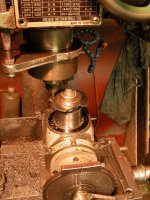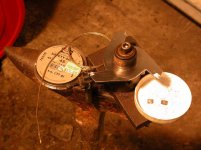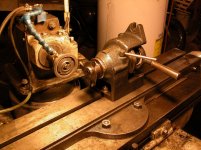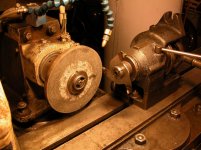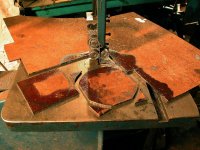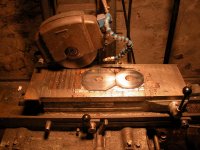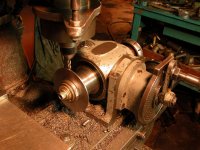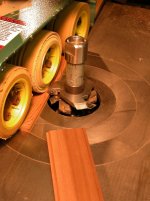You are using an out of date browser. It may not display this or other websites correctly.
You should upgrade or use an alternative browser.
You should upgrade or use an alternative browser.
truing a 6 wing cutter
- Thread starter fradrums
- Start date
1/4" collet, indicate the shank of the cutter, when your happy with that, indicate the cutter heads, use one of those flat heads that you can buy for your indicator.
Then mount your router to the tool post and use a grinding wheel at the lovest rpm possible. You will have to hone each cutter head after that.
Then mount your router to the tool post and use a grinding wheel at the lovest rpm possible. You will have to hone each cutter head after that.
What 6 wing cutter ?
Threaded one, whiteside 6801 or a slot cutter bit with 5/16 hole?
Threaded one, whiteside 6801 or a slot cutter bit with 5/16 hole?
What 6 wing cutter ?
Threaded one, whiteside 6801 or a slot cutter bit with 5/16 hole?
I'm using the Whiteside ones.
If you have the whiteside 6801, I've had mine ground here .http://www.farrstools.com/main.html
anyone know how to true up a 6 wing cutter ?
or where to send them to be trued so all 6 wings are cutting ?
To what tolerances?
That's not trivial, because few have a spindle, collet system, and collets that are "true".
A lot of times the collet the tool was sharpened in is not all that high precision. So it is true as sharpened, but runs out in your spindle. If you are talking a few .001" s.
I make most of my shaper and moulding cutters, though not so many of my router bits and cutters. However, the process is the same. When making them. just set the index or DH to the required # of teeth. When re-sharpening, it is arguable that a finger rest is more accurate than an index because it accepts the tooth position as built, rather than as theoretical. However, if the teeth are sharpened all over, face, top and sides, & none fall outside the hard stops on the index, the position is re-defined anyway. If you only sharpen the tips (top) then the face should be the reference and a finger rest used, so the teeth are all the same length regardless if they are exactly 60° apart (for a 6 wing cutter). I re-sharp (or re-size) router bits that are "worth it" very similar to this: All wheels are diamond.
PS carbide dust is about on par with asbestos for your lungs, maybe worse since it is not only an irritant but actively poisonous as well. It is also bad for your skin, but most people will not have a reaction. Still bad, though. It's worth letting other people do the sharpening.
While we are on tool-building, i much prefer Stellite ("Tantung") for woodworking cutters. It gets sharper, lasts longer on clean wood, and can be sharpened with regular aluminum oxide wheels.
Attachments
JC
Coos Cues
If you have the whiteside 6801, I've had mine ground here .http://www.farrstools.com/main.html
I have 3 of these that I have sharpened locally for 8 bucks a piece.
I still use a bosch colt router and I have more confidence in my sharpening guy than the router. Not sure it's possible to make all 6 cut evenly without a real spindle.
JC
I kind of got carried away answering your first Q
For a practical answer, if you have a DI or DTI, it is relatively fast and simple to match cutter tips that are within a few .001's, to near "dead nuts" with only a good, fine, diamond hand hone (lap). Use the indicator to locate the high teeth, mark them with a sharpy, and then hone, keeping the lap dead flat to the existing geometry. "Touch" the face occasionally, do not rock the lap. But concentrate on the back of the tip. Don't round over the tip or knock the tip off without taking the whole back of the bevel down flat.
Don't lap very far before checking with the dial indicator or dial test indicator again - diamond on carbide is fast.
Don't use a coarse lap, it tends to micro chip the edge.
As all of us here have alluded - the cutters will then be true in the spindle they were sharpened, only at that position. Rotate the cutter, or the shank of the cutter in the collet, or the collet in the spindle, and all bets are off. You might actually have doubled the error between position sharpened, and 180° re-position.
DI = dial indicator, has plunger. DTI = dial test indicator, has finger/stylus
DTI is less likely to micro chip tooth when checking. Either can chip it.
smt
anyone know how to true up a 6 wing cutter ?
For a practical answer, if you have a DI or DTI, it is relatively fast and simple to match cutter tips that are within a few .001's, to near "dead nuts" with only a good, fine, diamond hand hone (lap). Use the indicator to locate the high teeth, mark them with a sharpy, and then hone, keeping the lap dead flat to the existing geometry. "Touch" the face occasionally, do not rock the lap. But concentrate on the back of the tip. Don't round over the tip or knock the tip off without taking the whole back of the bevel down flat.
Don't lap very far before checking with the dial indicator or dial test indicator again - diamond on carbide is fast.
Don't use a coarse lap, it tends to micro chip the edge.
As all of us here have alluded - the cutters will then be true in the spindle they were sharpened, only at that position. Rotate the cutter, or the shank of the cutter in the collet, or the collet in the spindle, and all bets are off. You might actually have doubled the error between position sharpened, and 180° re-position.
DI = dial indicator, has plunger. DTI = dial test indicator, has finger/stylus
DTI is less likely to micro chip tooth when checking. Either can chip it.
smt
That's not trivial, because few have a spindle, collet system, and collets that are "true".
A lot of times the collet the tool was sharpened in is not all that high precision. So it is true as sharpened, but runs out in your spindle. If you are talking a few .001" s.
I make most of my shaper and moulding cutters, though not so many of my router bits and cutters. However, the process is the same. When making them. just set the index or DH to the required # of teeth. When re-sharpening, it is arguable that a finger rest is more accurate than an index because it accepts the tooth position as built, rather than as theoretical. However, if the teeth are sharpened all over, face, top and sides, & none fall outside the hard stops on the index, the position is re-defined anyway. If you only sharpen the tips (top) then the face should be the reference and a finger rest used, so the teeth are all the same length regardless if they are exactly 60° apart (for a 6 wing cutter). I re-sharp (or re-size) router bits that are "worth it" very similar to this: All wheels are diamond.
PS carbide dust is about on par with asbestos for your lungs, maybe worse since it is not only an irritant but actively poisonous as well. It is also bad for your skin, but most people will not have a reaction. Still bad, though. It's worth letting other people do the sharpening.
While we are on tool-building, i much prefer Stellite ("Tantung") for woodworking cutters. It gets sharper, lasts longer on clean wood, and can be sharpened with regular aluminum oxide wheels.
A really great post and very nice photo's.
A very under rated part is the concentricity of the Spindle taper and the concentricity of the collets themselves. Not all places have very high tolerance holders for the cutter grinding. Some times having a collet that is not concentric can be used to centralise an off centre ground cutter. Another way is having an adaptor that is designed to be adjusting the radial offset of the collet chuck. Not normally found on router spindles, but is found on EDM electrode holders.
Neil
A lot of times the collet the tool was sharpened in is not all that high precision. So it is true as sharpened, but runs out in your spindle. If you are talking a few .001" s.
I make most of my shaper and moulding cutters, though not so many of my router bits and cutters. However, the process is the same. When making them. just set the index or DH to the required # of teeth. When re-sharpening, it is arguable that a finger rest is more accurate than an index because it accepts the tooth position as built, rather than as theoretical. However, if the teeth are sharpened all over, face, top and sides, & none fall outside the hard stops on the index, the position is re-defined anyway. If you only sharpen the tips (top) then the face should be the reference and a finger rest used, so the teeth are all the same length regardless if they are exactly 60° apart (for a 6 wing cutter). I re-sharp (or re-size) router bits that are "worth it" very similar to this: All wheels are diamond.
PS carbide dust is about on par with asbestos for your lungs, maybe worse since it is not only an irritant but actively poisonous as well. It is also bad for your skin, but most people will not have a reaction. Still bad, though. It's worth letting other people do the sharpening.
While we are on tool-building, i much prefer Stellite ("Tantung") for woodworking cutters. It gets sharper, lasts longer on clean wood, and can be sharpened with regular aluminum oxide wheels.
A really great post and very nice photo's.
A very under rated part is the concentricity of the Spindle taper and the concentricity of the collets themselves. Not all places have very high tolerance holders for the cutter grinding. Some times having a collet that is not concentric can be used to centralise an off centre ground cutter. Another way is having an adaptor that is designed to be adjusting the radial offset of the collet chuck. Not normally found on router spindles, but is found on EDM electrode holders.
Neil
Thomas Wayne mentioned about his custom made wing cutter and arbor.A really great post and very nice photos.
A very under rated part is the concentricity of the Spindle taper and the concentricity of the collets themselves. Not all places have very high tolerance holders for the cutter grinding. Some times having a collet that is not concentric can be used to centralise an off centre ground cutter. Another way is having an adaptor that is designed to be adjusting the radial offset of the collet chuck. Not normally found on router spindles, but is found on EDM electrode holders.
Neil
The hole on the wing cutter is tapered and matches the arbor.
I wish he had it patented and sold the rights.
That would be awesome.
Take your arbor and bits to the local grinder .
They can sharpen and OD the bits with the matching arbor.
As it is now with straight arbors and holes on the bits with some play, you have to tap the bit to get the tips concentric.
That's not trivial, because few have a spindle, collet system, and collets that are "true".
A lot of times the collet the tool was sharpened in is not all that high precision. So it is true as sharpened, but runs out in your spindle. If you are talking a few .001" s.
I make most of my shaper and moulding cutters, though not so many of my router bits and cutters. However, the process is the same. When making them. just set the index or DH to the required # of teeth. When re-sharpening, it is arguable that a finger rest is more accurate than an index because it accepts the tooth position as built, rather than as theoretical. However, if the teeth are sharpened all over, face, top and sides, & none fall outside the hard stops on the index, the position is re-defined anyway. If you only sharpen the tips (top) then the face should be the reference and a finger rest used, so the teeth are all the same length regardless if they are exactly 60° apart (for a 6 wing cutter). I re-sharp (or re-size) router bits that are "worth it" very similar to this: All wheels are diamond.
PS carbide dust is about on par with asbestos for your lungs, maybe worse since it is not only an irritant but actively poisonous as well. It is also bad for your skin, but most people will not have a reaction. Still bad, though. It's worth letting other people do the sharpening.
While we are on tool-building, i much prefer Stellite ("Tantung") for woodworking cutters. It gets sharper, lasts longer on clean wood, and can be sharpened with regular aluminum oxide wheels.
A really great post and very nice photo's.
A very under rated part is the concentricity of the Spindle taper and the concentricity of the collets themselves. Not all places have very high tolerance holders for the cutter grinding. Some times having a collet that is not concentric can be used to centralise an off centre ground cutter. Another way is having an adaptor that is designed to be adjusting the radial offset of the collet chuck. Not normally found on router spindles, but is found on EDM electrode holders.
Neil
Interesting stuff, could you expand on how you make your own cutters? I'm guessing you start of with round stock, drill a hole for the arbor, part of and go from there?
I have one of those Deckl type grinders, can that be used?
Interesting stuff, could you expand on how you make your own cutters? I'm guessing you start of with round stock, drill a hole for the arbor, part of and go from there?
I have one of those Deckl type grinders, can that be used?
I'm not a complete moron
So most tooling is because it has to be made (by me, or $$$$ to a custom tool shop) to do a specific job.
Whenever possible or economical, i re-shape, re-size or re-configure an off the shelf cutter. However, as in the example shown, there are a lot of times when i need a specific diameter and thickness cutter to use as part of a stack of cutters, for a given operation.
Within that context, i will use either flat plate, or a round & part it off, depending which is fastest to get to where the goal is. An ideal substrate for cutters that will be tipped with carbide or stellite would be 4140 prehard. But in a rush i will use whatever is nearby, even structural steel (A36). A36 is not ideal, it is soft and gummy. (easy to bend a thin cutter body) It does work, though. I sometimes use it for thicker, insert tooth cutters with replaceable tips mostly because it is cheap. For large cutters it is faster for me to use plate, since parting off a round say 3" or 4" diameter is not easy on my smaller machines.
The cutters being described are straight, slotting, and angle type cutters as opposed to moulding cutters. Moulding cutters are primarily made from HSS steel here.
I'm not familiar with the Deckel, but if is is the SO single lip type, i have read they are not overly practical for multi-wing/multi-tooth cutters. They seem to be perfect for pantograph single lip cutters. I have a Gorton 3D panto, but do the cutters either on a tool and cutter grinder, or with a fixture on one of the surface grinders. My impression re: the Deckel is that the only issue is indexing the cutters, so if you have that figured out, it might work fine, i just have no experience.
I'm also not trying to be a smart-ass posting this stuff on here, more "this type activity is not in-accessible, here's what some of it looks like for practical use at a hobby or small shop level".
Sorry about the surface grinder pic - first cut with paper under it to protect chuck from rust and to even out the contact. Could not seem to edit to get a better pic of later stages/finish grinding.
Attachments
Last edited:
POSTS OF THE MONTH AWARD?
Goes to Ssonerai.
Great posts, Thanks for sharing.
(I will not be making my own, this thread will not help me but the postings are awesome. I use a full size router and my bits use a 1/2" shank. I use BamCarbide in Salem Oregon to sharpen them. He can look at one and know if it's cutting wrong and yes, the collets are not always perfect.)
Thanks again to the Poster of the Month.
Goes to Ssonerai.
Great posts, Thanks for sharing.
(I will not be making my own, this thread will not help me but the postings are awesome. I use a full size router and my bits use a 1/2" shank. I use BamCarbide in Salem Oregon to sharpen them. He can look at one and know if it's cutting wrong and yes, the collets are not always perfect.)
Thanks again to the Poster of the Month.
David - from you I take that as very high praise.
However, so tangentially related to cue making it should be disqualified from competition.
Just got carried away where there's a subject i can contribute a little on.
Sometime in the next month or so it will be necessary to make cutters to try first 6 point full splice and i hope to post some of effort here to bring it back more in the direction of pool and cue-making. Should be interesting, hope to get there without too many failures.
smt
However, so tangentially related to cue making it should be disqualified from competition.
Just got carried away where there's a subject i can contribute a little on.
Sometime in the next month or so it will be necessary to make cutters to try first 6 point full splice and i hope to post some of effort here to bring it back more in the direction of pool and cue-making. Should be interesting, hope to get there without too many failures.
smt
I'm not a complete moron
So most tooling is because it has to be made (by me, or $$$$ to a custom tool shop) to do a specific job.
Whenever possible or economical, i re-shape, re-size or re-configure an off the shelf cutter. However, as in the example shown, there are a lot of times when i need a specific diameter and thickness cutter to use as part of a stack of cutters, for a given operation.
Within that context, i will use either flat plate, or a round & part it off, depending which is fastest to get to where the goal is. An ideal substrate for cutters that will be tipped with carbide or stellite would be 4140 prehard. But in a rush i will use whatever is nearby, even structural steel (A36). A36 is not ideal, it is soft and gummy. (easy to bend a thin cutter body) It does work, though. I sometimes use it for thicker, insert tooth cutters with replaceable tips mostly because it is cheap. For large cutters it is faster for me to use plate, since parting off a round say 3" or 4" diameter is not easy on my smaller machines.
The cutters being described are straight, slotting, and angle type cutters as opposed to moulding cutters. Moulding cutters are primarily made from HSS steel here.
I'm not familiar with the Deckel, but if is is the SO single lip type, i have read they are not overly practical for multi-wing/multi-tooth cutters. They seem to be perfect for pantograph single lip cutters. I have a Gorton 3D panto, but do the cutters either on a tool and cutter grinder, or with a fixture on one of the surface grinders. My impression re: the Deckel is that the only issue is indexing the cutters, so if you have that figured out, it might work fine, i just have no experience.
I'm also not trying to be a smart-ass posting this stuff on here, more "this type activity is not in-accessible, here's what some of it looks like for practical use at a hobby or small shop level".
Sorry about the surface grinder pic - first cut with paper under it to protect chuck from rust and to even out the contact. Could not seem to edit to get a better pic of later stages/finish grinding.
Interesting stuff for sure, might be a bit overkill for cuework though. You can index with a Deckel grinder, I`ve used it with great success.
is it really important to make all 6 cutting edges the same length???
Kim
Faster and smoother cuts and less stress on the wood(sounds wonderful)
Mario
